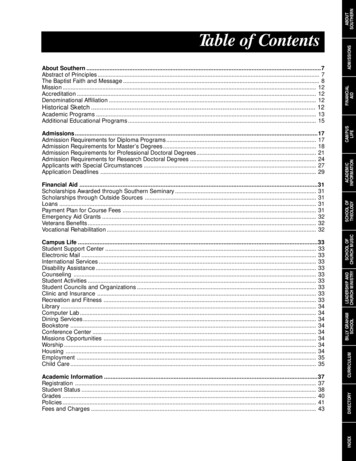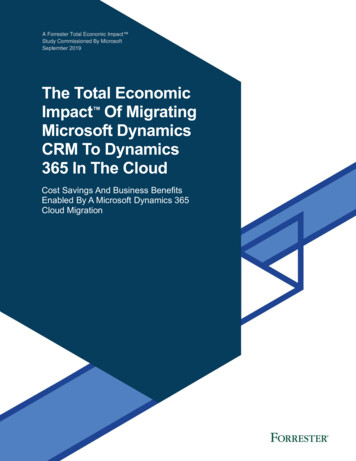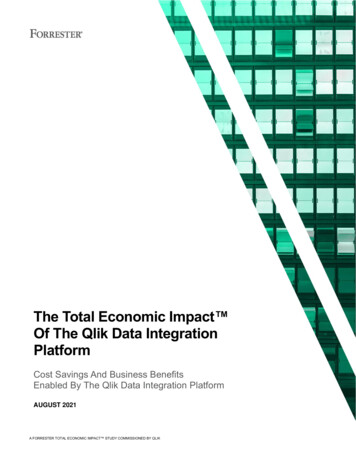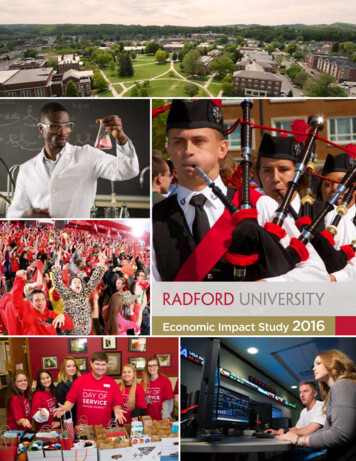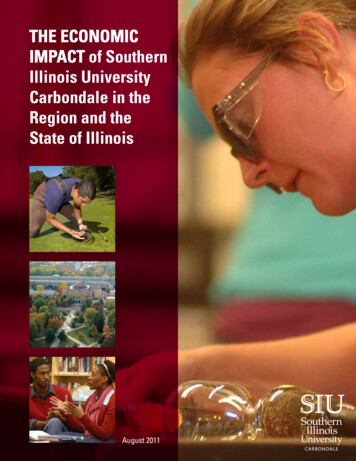
Transcription
The EconomicImpact of SouthernIllinois UniversityCarbondale in theRegion and theState of IllinoisAugust 2011
The Economic Impact of Southern Illinois UniversityCarbondale in the Region and the State of IllinoisSubhash C. SharmaChair, Department of EconomicsAboubacar DiabyGraduate Student, Department of EconomicsandKyle HarfstExecutive Director, Southern IllinoisResearch Park SIUCAugust 29, 2011
AcknowledgementsFirst of all, we would like to thank Chancellor Rita Cheng for approving andsupporting this economic impact study.This study would not have been possible without the cooperation of many colleagues inCarbondale and Springfield. We would like to thank Judith Marshall and her colleagues:Wally Burman, Debbie Abbell, Victoria Peter, Charles Cox, Jeffrey Wright and LorenCook and others for providing data related to salary and wages, purchasing expenditures,grants and awards, etc.; Larry Schilling and his colleagues for a variety of institutionaldata; Phil Gatton, Christina Gilbert and their colleagues for providing data on capitalspending and permanent improvement over ten years; Terri Harfst for estimatesof student spending and information regarding financial aid; Timothy Marlo forinformation about our Alumni and expenditures of the SIU Alumni Association; LibbyBanycky for expenditures of the SIU Foundation; Mary Nippe for detailed informationconcerning annuitants; Jason King for detailed discussion and information regardingvisitors to athletic events; Julie Payne-Kirshmeier, Tiffany Spencer, Angela Royal, WilliamEhling, Sandra Rhodes, among many others, for providing information for this study.We would like to thank Gary Giacomelli, Assistant Provost in Institutional Planningand Management Information, for providing us with an understanding of the detailedoperation of the School of Medicine (SOM) and SIU Health Care providing some data forSOM and editing the SOM section in this document.We would also like to thank Vice Chancellor for Research John Koropchak fordiscussion and information relevant to research, John Mead and Peter Filip for providinginformation about the Coal Research Center and Center for Advanced Friction Studies.We would like to acknowledge Deans Dennis Credit, Cynthia Fountaine, Gary Kolb,Terry Owens, Kenneth Teitelbaum and Alan Vaux, and Acting Associate Dean LizetteChevalier and Assistant Dean Julia Wetstein for providing information related toeconomic impact activities of their respective colleges.Last, but not the least, we would like to acknowledge helpful discussions in the earlystages of this study with Ira Altman, Department of Agribusiness Economics and BasharatPitafi, Department of Economics, and their help in researching literature relevant touniversity impact studies.ii
Executive Summary This 4.07 billion in impact creates an additional 7.4 billion ineconomic activity in the state; i.e. each year’s SIUC graduatescreate about 11.4 billion economic activity (in 2010 dollarvalue) in the long-run.Southern Illinois University Carbondale (SIUC), in itssecond century, is the largest employer in southern Illinois and isthe engine of economic growth in southern and central Illinois.The Southern Illinois University School of Medicine (SOM)has its primary educational and research facilities in Springfieldand Carbondale; a clinical campus in Springfield; regionalpatient care and resident training in Springfield, Carbondale,Decatur, and Quincy; and patient care and educational outreachsites throughout central and southern Illinois. The SOM hasaffiliations with teaching hospitals in Springfield, Carbondale,Decatur, and Quincy. Thus, SIUC is not only the engine ofeconomic growth in southern Illinois but contributes significantlyto the economy of central Illinois and the State of Illinois. Each 1.00 appropriated by the state to SIUC generatesapproximately 38.60 of economic activity in the long-run inthe state. FY10 graduates will pay at least 458.8 million in state and localtaxes (in 2010 dollar value) in their work life. Comparing this to 296.2 million state appropriation for FY10, there is a net gainof 162.6 million to the state. Each 1.00 appropriated by the state will generate 1.55 in stateand local taxes in the long-run.The contribution of SIUC to the economy of Illinois,to southern and central Illinois (23 counties in southernIllinois: Alexander, Edwards, Franklin, Gallatin, Hamilton,Hardin, Jackson, Jefferson, Johnson, Massac, Monroe, Perry,Pope, Pulaski, Randolph, St. Clair, Saline, Union, Wabash,Washington, Wayne, White, and Williamson; and 9 counties incentral Illinois, i.e. Adams, Christian, Logan, Macon, Macoupin,Menard, Montgomery, Morgan, and Sangamon), and tosouthern Illinois (twenty three counties) is estimated here forthe Fiscal year 2010, i.e. from July 1, 2009 to June 30, 2010. Thecontribution of SOM to the economy of ten counties (9 countiesof central Illinois cited above and Jackson County) is alsoestimated for the same time period.C. Overall Impact: Ultimately (in the long-run and short-run) each 1.00appropriated by the state to SIUC will return 2.00 in the form ofstate and local taxes, and will generate 46.00 of economic activityin the state. Of nearly 210,000 alumni, at least 104,600 are living in Illinoisthus providing an impact to the state. This includes 44,752alumni in the southern and central Illinois, and 37,000 alumniin the 23 county region of southern Illinois. Moreover, 2,436SIUC annuitants also live in Illinois. SIUC alumni and annuitantscontribute annually 17.4 billion to economic activity in Illinoisand they also generate directly and indirectly, 1.1 billion in stateand local taxes.SIUC Impact on Illinois EconomyA. Annual Impact (Short-Term)SIUC Impact on the southern and centralIllinois Economy SIUC contributes approximately 2.3 billion in economicactivity annually to the Illinois economy. Both directly and indirectly SIUC supports approximately23,903 jobs in the state and about 1.19 billion in personalincome (a component of the state output). SIUC activities contribute approximately 1.4 billion, 17,707jobs (directly and indirectly) and 837.8 million in personalincome to the southern and central Illinois (32 counties)economy. For every 1.00 appropriated by the state to SIUC, it generatesroughly 7.72 of economic activity annually in the state. Every 1.00 appropriated by state, generates roughly 4.65 worthof economic activity in the southern and central Illinois region. For every 1.00 appropriated by the state to SIUC, 41 cents( 0.41) are returned to the state and local governments in taxrevenues annually. Annually around 66.83 million in state and local taxes areattributable to the southern and central Illinois region, i.e. for 1.00 appropriated by state, this region returns around 0.23 inthe form of state and local taxes.B. Long-Term Impact: SIUC contributes approximately 8.14 billion in increasedexpected work life earnings for its graduates each year. Fiftypercent of the SIUC graduates stay in Illinois, and thus 4.07billion gets circulated in the Illinois economy.iii
SIUC Economic Impact in southern IllinoisIn addition to monetary contributions, SIUC providesextensive community service activities to the region and the stateof Illinois. Community service activities may be classified broadlyin terms of economic development, health and social services,culture and volunteerism. In FY 2010, the Office of Economic andRegional Development assisted 51 businesses in southern Illinoisstart and expand their companies. This past year more than 3,600students provided 50,965 hours of service to regional not-for-profitorganizations. SIUC contributes approximately 859.1 million of totaleconomic activity in the southern Illinois region, directly andindirectly supports 12,402 jobs and generates approximately 551.5 million in personal income. Every 1.00 appropriated by the state to SIUC generatesapproximately 2.90 of economic activity in the SouthernIllinois region.The School of Medicine provides a significant amountof community service via specialty and primary care at 100outreach sites in nearly 50 communities. The SOM routinelyprovides a number of public education programs around theregion concerning cancer, diabetes, back pain, sports medicine,Alzheimer’s disease and Parkinson’s disease just to name a few. TheSOM also regularly holds continuing medical education sessions forphysicians and other health care providers. 43.12 million in the state and local tax revenues are generatedby the SIUC activities in the southern Illinois region.School of Medicine Economic Impact During FY 2010 the SIU School of Medicine contributedapproximately 331.8 million in total economic activities(output) in the 10 county region A total of 3,801 jobs (direct, indirect and induced) were createdas a result of the SIU School of Medicine SOM activities generated 14.5 million in direct and indirect(households, corporations, indirect business tax and employeecompensation) taxes to the state of Illinoisiv
A. Southern Illinois University Carbondalepublic at large. Its programs of public service and its involvementin the civic and social development of the region are manifestationsof a general commitment to enhance the quality of life throughthe exercise of academic skills and application of problem-solvingtechniques. SIUC seeks to help solve social, economic, educational,scientific, and technological problems, and thereby to improve thewell-being of those whose lives come into contact with it. 1”Southern Illinois University Carbondale was established in1869 as Southern Illinois Normal College (SINC). Instructors atSINC began in 1874 for a two-year teacher training program and by1904 students were enrolled in four-year degree programs. In 1943,SINC was transformed into Southern Illinois Normal University(SINU) and graduate courses and Master’s degree in educationstarted the same year. By action of the Illinois General Assembly, in1947 SINU was renamed as the Southern Illinois University (SIU)and became a comprehensive research institution during the nexttwenty years. Ph.D. programs started in 1955 and the first doctoraldegree was granted in 1959.The mission of the School of Medicine has an added specific missionin addition to the SIUC mission, i.e., “to assist the people of centraland southern Illinois in meeting their healthcare needs througheducation, patient care, research and service to the community. 2”In addition to the mission and focus statements of SIUC,there “is an explicit commitment to the tradition of affirmativelysupporting the educational needs of underrepresented anddisadvantaged populations in the state. 3” To achieve theseobjectives, SIUC has established priorities and one of thepriorities is, “to build public and private sector partnershipsthat address the state’s needs and strengthens the university’sleadership role in the region. 4”To serve the greater Southern Illinois region, SIU started offeringoff-campus courses in metropolitan East St. Louis area in 1949.In 1965, this led to the development of a separate campus atEdwardsville. In 1969, two campuses became as the SouthernIllinois University (at) Carbondale (SIUC) and the Southern IllinoisUniversity (at) Edwardsville (SIUE) under the SIU System. Alsoin the same year, the General Assembly approved two professionalschools, i.e. School of Law and School of Medicine. The SouthernIllinois University School of Medicine (SOM) began in 1970 andthe School of Law in 1973.SIUC has been accredited since 1913 under severalinstitutional names. Master’s degree programs were accreditedin 1944 and in 1969 full accreditation at the doctoral level wasattained. SIUC has had full accreditation since 1979 from theNorth Central Association. This accreditation is renewed everyten years, and the latest renewal came in 2010. Since 2005, SIUC(including SOM) has been classified as a “Research University:High Research Activity,” by the Carnegie Foundation for theAdvancement of Teaching. This is their second highest tier basedon research productivity. Prior to 2005, SIUC was classified as aCategory II research institution by the Carnegie Foundation. TheCarnegie Foundation changed their classification categories in2006.At present SIUC has a diverse undergraduate and graduateprograms offered by eight academic colleges, the Graduate Schooland two Professional Schools: Agricultural Sciences, Business,Education and Human Services, Engineering, Liberal Arts, MassCommunication and Media Arts, Science, Applied Sciences andArts; and the School of Law and the School of Medicine (SOM).The SOM has its primary educational and research facilities inSpringfield and Carbondale; a clinical campus in Springfield;regional patient care and resident training in Springfield,Carbondale, Decatur, and Quincy; and patient care and educationaloutreach sites throughout central and southern Illinois. The firstyear of the four year M.D. program is offered at the Carbondalecampus and then students move to Springfield in the beginning oftheir second year.SIUC owns 480 buildings (including School of Medicine inSpringfield), leases 22 buildings in Springfield and manages oneof the buildings owned by the Illinois Department of NaturalResources. SIUC and SOM have a total area of 8,475 acres with8,456,424 building square feet.5The SIUC mission statement is available online as well as inthe undergraduate and graduate catalogs. Here the first and lastparagraphs are quoted:“Southern Illinois University Carbondale, now in its secondcentury, is a major public higher education institution dedicatedto quality academic endeavors in teaching and research, tosupportive programming for student needs and development, toeffective social and economic initiatives in community, regional,and statewide contexts, and to affirmative action and equalopportunity.”“Even as SIUC constantly strives to perpetuate high quality in bothinstruction and research, it continues a long tradition of service toits community and region. Its unusual strengths in the creative andperforming arts provide wide-ranging educational, entertainment,and cultural opportunities for its students, faculty, staff, and the1 http://www.siu.edu/bot/leg/policies.html#1A2 http://www.siumed.edu/; http://www.siumed.edu/news/brieflook09.pdf3 Factbook 2009-10, p. 6.;4 Factbook 2009-10, p. 6.5 Factbook 2009-10, p. 21.1
B. Programs, Degrees Awarded, Studentsand Financial AidC. Methodology and Channels ofEconomic ImpactStarting as a small two year teaching college in 1869, SIUChad 32 doctoral and professional (Law/Medicine) programs, 74master’s degree programs, 10 post-Baccalaureate certificates, 101Bachelor of Arts/Sciences (most with minors and specializations)and 2 Associate degree programs during FY 2010. The first degreewas awarded by SIUC in 1876 and since then 269,195 degreeshave been awarded through FY10. During FY10, a total of 5,430degrees were awarded: Professional Practice: 205 (Medicine:71; Law: 134); Doctorate: 157; Master’s: 950; Bachelors: 4,039;Associates: 66; and 13 Post-Baccalaureate certificates.C.1 MethodologyTo estimate the contribution of SIUC to the regional and stateeconomy we used the IMPLAN (Impact Analysis and Planning;Version 3) software and database developed by the MinnesotaIMPLAN group. IMPLAN software is the most commonly usedsoftware to estimate economic impacts. The IMPLAN uses theInput-Output model developed by Nobel Laureate Professors inEconomics, Wassily Leontief and Richard Stone. The IMPLANsoftware classifies the economy in 440 different sectors and theinput-output model expresses relationships between these sectors.During Fall 2009, there were 20,350 total students enrolled:15,511 undergraduates; 4,121 graduates (including Medical/Dental Education Preparatory Program students); 385 lawstudents; and 293 in the School of Medicine. SIUC has a longtradition of embracing students who are first generation intheir families to attend a university; and/or students from theacademically underserved; and/or economically disadvantagedareas, and minority and disabled students. During Fall 2009, 24%of students were minority students; 45.5% were women, 54.5%men and 6% were international students. The average ACT ofthe freshman class in Fall 2009 was 21.6, above the state averageof 20.8. During Fall 2009, 58% of new undergraduate transferscame from public community colleges in Illinois, 81% of the totalstudents were from Illinois, and 25% came from out-of-state and/or from other countries. In the Fall of 2009 the percentage ofnew freshmen coming from outside the state increased to 8%,compared to 4% in Fall 2008. (The above statistics are from theFact book 2009-10).Three kinds of effects are estimated by IMPLAN, i.e. DirectEffects, Indirect Effects, and Induced Effects. Direct effects arethe initial changes in an industry when purchases are made bySIUC of goods and services for its operations. These includechanges in production and employment in a specific industry.Indirect effects are the effects created in other industries by thepurchases of goods and services in the directly affected industries.The directly and indirectly affected industries generate householdincome which further affect the local industries. These effects arecalled induced effects.The direct, indirect and induced effects generate economicactivities including output, employment, labor income and valueadded into the economy of the region. Labor income here consistsof employee compensation and proprietary income. EmployeeCompensation includes wages, salaries and benefits. Benefitsinclude retirement payments, health and life insurance and anyother non-cash payments. Proprietary Income is the incomereceived by self-employed individuals, e.g. private business owners,doctors, lawyers and so on. Indirect Business Taxes are the excisetax and sales tax paid by individuals to businesses.The SIUC Financial Aid Office provides a service to studentsby awarding financial aid to assist in paying for post-secondaryeducation. In FY 10, 282 million was awarded from federal,state, institutional and private sources in the form of grants,scholarships, loans and student employment. This representsan increase of 7.4% from the previous year. During FY10, 85%of students received some form of financial aid, with gift aidexceeding all other areas. The Financial Aid Office packaged15,767 students through their office. For the last five years thestudent’s financial aid is reported below.6C.2 Channels of Economic ContributionSIUC contributes to the state economy annually, i.e. in theshort-run, and also in the long-run. The annual contribution ofSIUC to the Illinois and regional economies is through manychannels, i.e. i) the impact of SIUC employee’s spending, ii)the impact of student’s spending, iii) the impact of university’spurchases and operating expenses, iv) the impact of the capital/permanent improvement projects, i.e. construction of newstructures and improvement of existing ones, v) the impact ofresearch grants generated by SIUC, vi) the impact of visitors to theregion due to SIUC. We call their impact as the short-term effect.SIUC absorbs a loss of tuition and certain fees for manyconstituents to assist the region: the cost of entitlements forIllinois Veterans and Illinois National Guards when these arenot fully funded by the State; teacher special education; IllinoisGeneral Assembly; Illinois Air Force ROTC; Illinois Army ROTC;Graduate Assistants; Faculty, Staff, Civil Service, and Civil ServiceMilitary Programs; children of SIUC employees; children of stateuniversity employees; NCAA Men and Women; Medical Preparation Waivers; and others. During FY10, these waivers were 26.8million and 103.7 million for the past five years, as indicated inthe table below.vii) The graduates of SIUC who work in Illinois contribute to thestate economy for the next 40 years of their work life. This we callthe long-term contributions of SIUC to the economy of Illinois.6 Factbook 2010-11.2
Tab1e 1: Student Financial Aid – Five Year ComparisonFY06 107,143,447Federal 25,330,049StateInstitution 58,099,184 12,503,871OtherTotal 203,076,551FY07 109,133,530 28,613,051 62,540,315 15,221,383 215,508,279FY08 119,684,468 28,011,332 70,801,721 17,195,209 235,692,730FY09 138,524,864 28,039,438 79,576,960 16,540,300 262,681,562FY10 167,951,969 25,087,970 74,868,756 14,094,918 282,003,613Table 2: Tuition WaiversFY06FY07FY08Cost of Veterans 1,479,345 1,774,346 2,118,413*EntitlementsOther Tuition 13,524,880 15,678,920 18,429,886WaiversTotal 15,004,225 17,453,266 20,548,299In addition to these, viii) the earnings and spending of SIUCalumni working in Illinois, and ix) the SIUC annuitants living inIllinois also contribute annually to the economy of Illinois.FY09 2,289,285FY10 2,748,22821,617,72224,064,182 23,907,007 26,812,240service, administrative professional, and 2082 graduate assistants.We have not included approximately 5,300 student workers,including housing resident assistants, undergraduate assistantsand undergraduate research assistants. Their spending is capturedin student spending. Total salaries and benefits for southernIllinois (23 counties) were 333.1 million and for southern andcentral Illinois (32 counties) were 485.1 million. The number ofemployees in southern and central Illinois and southern Illinoiswere 8834 and 6777 (including graduate assistants, residents andfellows) respectively.Finally, the most important impact of SIUC which cannotbe quantified is the effect on the community through socialand voluntary services provided by SIUC and SOM employeesand students, and the SIUC graduates overall being theresponsible citizens.i) Employees’ Salaryii) Student SpendingDuring FY10, SIUC paid a total of 516.1 million in salariesand fringe benefits to its 9,633 (including graduate assistants,residents and fellows) employees in Illinois.7 This includes theSchool of Medicine, the President’s Office and university wideservices employees. This also includes 13.6 million in stipendspaid to residents and fellows of the SOM.8 Salaries also include 30.1 million paid by the SIU Healthcare as compensation to 280SOM faculties for their clinical services. Employees are classifiedas the total full time and part time employees of SIUC, SOM(including residents and fellows), President’s Office, and of theUniversity wide services. Employees include faculty, civilThe SIUC Office of Financial Aid estimates and providesan estimate of expenses to students for room and board, bookand supplies and of living expenses, in addition to tuition andfees. These expenses are provided for a nine month basis and forsummer school to the undergraduate, graduate and professionalstudents. To obtain the student spending we multiplied the numberof students by the average expenditure provided by the financial aidoffice. The total spending for the SIUC campus is 213.7 million.9With respect to student spending, we have not included graduateassistants, as these are treated as employees of SIUC.7 Employee count was provided by Human Resources, SIUC.8 These residents and fellows are paid by the hospitals they are affiliated with. Weassume that they generate at least the amount of services to the hospital they work9 We are estimating how much SIUC is contributing to the economy of Illinois.We are not answering a hypothetical question, if SIUC did not exist, how muchfor. Without SOM these residents and fellows would not be there.will be the loss to Illinois economy.3
vii) Work Life Earningsiii) - v) Operating Expenses: Including Capital Expenditure/Permanent Improvements and Research GrantsTo estimate the long-term contribution of SIUC to thestate of Illinois economy, we estimate the incremental work-lifeearnings of 2010 graduates.10 The common approach is to estimatethe net present value (NPV) of the future 40 years of incrementalwork life earnings by using the work life earnings estimateprovided by the US Census Bureau. We estimate the incrementalwork life earning as the additional earnings allowed by a collegedegree as compared to the earning of a typical high school degree.We observe that a doctoral degree will gain 2.9 million morethan a high school degree over a typical 40 years of work life. Forprofessional, masters and bachelors the incremental gains arerespectively 4.3 million, 1.95 million and 1.2 million.11During FY10, SIUC, including: SOM; the SIU President’sOffice; University Wide Services; the SIUC Foundation and theSIUC Alumni Association spent 196.2 million for the operationof the university. The major categories of these expenses werecontractual services, equipment, commodities, permanentimprovements/capital expenditures, telecommunications, utilities,equipment maintenance/rental, ground maintenance, travel, masstransit service among others. Out of these expenditures, 108.3million were spent in southern Illinois, 124.3 million in southernand central Illinois, 140.3 million in the State of Illinois and asizable amount, 55.9 million was spent outside the state of Illinois.vi) Visitors’ SpendingThe NPV of the work life earnings of FY10 graduates of SIUCis a measure of the contribution to the Illinois and the nationaleconomy in the long-run. The work life incremental earnings ofSIUC graduates of FY2010 are approximately 8.14 billion and aregiven below.During FY10, we estimated a total of 7.6 million visitorsspending in the southern Illinois region. Visitors included toall activities related to students and athletic events, i.e. familyweekend, homecoming, commencements, open houses, moving outweekend, some of the activities of various colleges, and visitors toall athletic events in Carbondale. In estimating visitor’s spending,we had meetings with a number of colleagues on campus and inthe community. This is a very conservative estimate. We have notincluded visitors to SIUC employees in the region.10 The incremental work life earnings have been estimated by some other economic impact studies of the universities. eg. Resel, R.;Hewing, G.J.D.; Lubotsky,D. amd Edwards, F.; The impact of the University of Illinois on the Economy ofour State, The Insitute of Government and Public Affairs, January 2009. Institutefor Economic Development; Economic Impact Study: A Study of the EconomicImpact of the university of Texas System, 2004.11 The cost of college education is a very small amount compared to the incremental work life earnings and so we have not taken this into account.4
Table 3: Work-Life increase in earnings of FY10 SIUC graduatesGraduatesa2010Work lifeearningsbDoctoral degreeProfessional degreeMasters degreeBachelors degreeSome universitydegree orAssociates' degree1572059504,039 4,556,660 5,923,540 3,556,327 2,812,058Incrementalearnings percgraduate 2,957,182 4,324,062 1,956,849 1,212,58079 1,977,788 378,311Total5,430Degree 10,828,984Total work lifeincremental earnings 464,277,605 886,432,792 1,859,006,502 4,897,610,216 29,886,553 8,137,213,669a Source: SIUC Fact book 2010-2011.b Source: Authors’ calculations following the methodology from “The big pay-off: Educational Attainment and Synthetic Estimates of Work-lifeEarnings”, US Bureau of census (2002). The data come from the Current Population Survey 2010 Annual Social and Economic Supplement, USBureau of Census. Work-life 10* Average earnings (for workers between 25 and 34) 10* Average earnings (for workers between 35 and 44) 10 *Average earnings (for workers between 45 and 54) 10*Average earnings (for workers between 55 and 64). The calculation concerns onlyfull time, year-round workers. All the average earnings were CPI adjusted to 2010 (1.5%) before the calculation.c The work life earning of a typical high school degree in 2010 dollars ( 1,599,478 ) is used as reference for the calculation of the incrementalearnings. i. e. the incremental earning for a given degree is the additional earnings above the earning of a typical high school degree.viii) SIUC Alumni EarningsSIUC had a total of 209,990 Alumni including School ofMedicine, and among these at least 104,599 are working inIllinois, 37,302 in Southern Illinois (23 county region), 44,752 inSouthern and Central Illinois (32 county region). Cook Countyhas the largest concentration of Alumni, i.e. 17,988 followed by11,436 in Jackson, 5,887 in Williamson, 5,770 in DuPage, 4,120in St. Clair, 4003 in Sangamon, and 2,709 in Franklin counties.However, there are 1300 to 1500 alumni in Perry, Randolph,Saline and Union counties.12 Among these, there are 214 SIUCgraduates who are teaching in K-12 schools in Illinois. As of2010 there are 82,861 Alumni with Baccalaureate degree, 8,121with Master’s degree, 1,082 with Doctoral degree, 836 Physicians(M.D.s), 1,791 with other professional degrees and 9,908 withsome college or Associate degree working in Illinois.13The US Bureau of Census provides the mean salary for eachdegree holders and for each age group. We used the mean salaryof full-time, year round workers between ages 25 and 64 for 2009.This was adjusted for 2010 by using CPI. The average salary forMD is the weighted average of SIU MD alumni, based on ModernHealthcare 2010 Physician compensation survey.12 As per record of the Alumni office.13 Data provided by the Alumni office.5
for 2009. This was adjusted for 2010 by using CPI.14 The average salary for MD is the weightedaverage of SIU MD alumni, based on Modern Healthcare 2010 Physician compensation survey.Table 4: Earnings of SIUC Alumni in 2010: Working in State of Illinois2010 Average salary Total 's82,86168,8395,704,068,379Doctorate degree1,082116,871126,454,595Master's degree8,12189,903730,099,096Medical Doctor836278,294232,653,546Other professional degree1,79115,15127,134,827Some college or ,358,912Table 5: Earnings of SIUC alumni in 2010: Working
1869 as Southern Illinois Normal College (SINC). Instructors at SINC began in 1874 for a two-year teacher training program and by 1904 students were enrolled in four-year degree programs. In 1943, SINC was transformed into Southern Illinois Normal University (SINU) and graduate courses and Master's degree in education started the same year.




